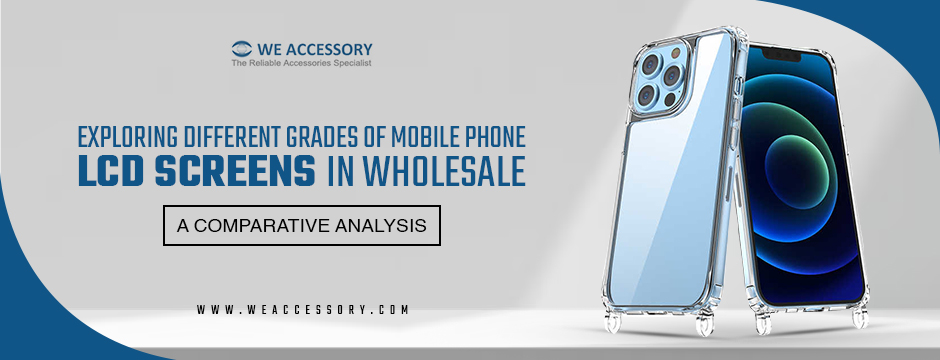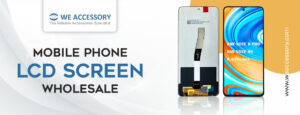Address:2F, Block A2, Nanchang Industrial area, Xixiang Town,Bao'an District, Shenzhen
Tel: +86-755-36818832
Mobile/Whatsapp: +86-15919800304
Email: sales@weaccessory.com
Skype: sunny.law86





Mobile phone LCD screens play a pivotal role in the functionality and user experience of smartphones, serving as the primary interface for displaying images, videos, and content. As technology advances, the demand for high-quality, reliable LCD screens has intensified within the smartphone industry. These screens not only define the visual clarity and responsiveness of devices, but also significantly impact consumer satisfaction.
Within the mobile phone LCD screen wholesale market, a diverse array of screen grades is available to cater to varying consumer needs and budget considerations. According to We Accessory, understanding the distinctions among these grades is paramount for retailers, repair shops, and manufacturers. This understanding helps to make informed decisions regarding the quality and performance of the screens they acquire.

OEM LCD screens are manufactured by the same company that produces screens for the original smartphones. These screens maintain the highest quality standards and are known for their compatibility and reliability. They typically command higher prices due to their authenticity and superior performance.
Aftermarket LCD screens are produced by third-party manufacturers not affiliated with the original smartphone brand. They aim to replicate OEM screens, but may vary in quality and performance. These screens are often more affordable than OEM options, but may exhibit differences in colour accuracy and touch sensitivity.
High copy LCD screens are replicas designed to imitate OEM screens, but often lack the same quality and performance. These screens are manufactured by unauthorized producers and are typically the least expensive option. While they may resemble OEM screens visually, their performance and durability can significantly differ.
Refurbished LCD screens are previously used screens that undergo repair or refurbishment processes to restore functionality. These screens are a sustainable option and may offer cost savings, but their performance and longevity might not match that of new screens.
The quality and classification of mobile phone LCD screen wholesale markets hinge on various pivotal factors.
The adherence to stringent manufacturing standards significantly influences the grades of LCD screens. Original Equipment Manufacturer (OEM) screens are crafted following precise specifications set by smartphone companies, ensuring high quality and uniformity. Conversely, aftermarket, high copy, and refurbished screens may vary in adherence to industry standards, affecting their overall quality.
The choice of components and materials used in screen production profoundly impacts screen quality. OEM screens utilize top-quality materials, resulting in superior performance and longevity. In contrast, other grades might compromise on material quality, affecting the screen’s durability and performance.
Rigorous quality control measures employed during manufacturing play a pivotal role in determining screen grades. OEM screens undergo meticulous testing and quality assurance protocols, ensuring consistent performance. However, screens from other grades may lack robust quality control, leading to variations in performance and reliability.
The reputation and credibility of the manufacturing brand significantly contribute to screen classification. Established brands with a track record of producing high-quality screens, such as OEM manufacturers, typically offer more reliable products. Conversely, lesser-known or unauthorized producers might produce screens of inferior quality.
Conducting a thorough comparative analysis among different LCD screen grades reveals their distinct advantages and drawbacks.
Each grade, available in the mobile phone LCD screen wholesale market, presents unique pros and cons. OEM screens excel in quality and compatibility but come at a higher price point. Aftermarket screens offer a balance between quality and cost, but may exhibit slight performance differences. High copy screens are budget-friendly, but often compromise on quality and longevity. Refurbished screens offer sustainability, but may lack consistency in performance due to prior usage.
Comparing key attributes like durability, colour accuracy, brightness, touch sensitivity, and compatibility helps in understanding the strengths and weaknesses of each grade. OEM screens typically excel in all these aspects, while other grades may show variations and trade-offs in performance.
This comparative analysis aids stakeholders in evaluating LCD screen options effectively, weighing the trade-offs between different grades based on specific requirements and priorities.
Varying LCD screen grades significantly impact retailers’ inventory choices and pricing strategies. Retailers face decisions regarding the selection of LCD screens to stock based on factors like quality, pricing, and customer demand. OEM screens, while offering top-notch quality, often come with higher acquisition costs, affecting the retailer’s pricing strategy. Conversely, opting for lower-grade screens might lower prices but could compromise on quality, potentially affecting customer satisfaction and return rates.
For consumers, the choice of smartphones or repair services is influenced by the quality of the LCD screens used. Consumers seeking high-end devices may prioritize smartphones with OEM screens, valuing reliability and performance over cost. On the other hand, individuals considering repair services might weigh options based on screen grades, balancing repair costs and screen quality. In the mobile phone LCD screen wholesale market, providing transparency about screen grades empowers consumers to make informed decisions aligning with their preferences and budget.

Quality assurance and reliability play pivotal roles in the wholesale purchase of LCD screens. Establishing consistent quality standards ensures that retailers receive screens meeting expected performance benchmarks. OEM screens usually adhere to stringent quality control measures, offering reliability and consistency. For other grades, investing in suppliers or manufacturers with established quality assurance processes becomes crucial to maintain product reliability.
To ensure consistent quality and reliability for retailers and end-users, several factors need consideration. Selecting reputable suppliers or manufacturers with a proven track record of delivering reliable screens is essential. Detailed specifications and testing protocols should be communicated to maintain quality standards. Moreover, establishing clear communication channels and reliable customer support helps address any quality-related concerns promptly.
Prioritizing quality assurance and reliability aids retailers in maintaining customer satisfaction and trust. For end-users, it ensures that the smartphones or repair services they opt for provide reliable and consistent performance, reflecting positively on their overall experience.
Understanding the intricacies of LCD screen grades is paramount for wholesalers, retailers, and consumers alike. The comparative analysis highlighted the diverse characteristics of OEM, Aftermarket, High Copy, and Refurbished screens, illuminating their pros and cons. Recognizing the impact of these grades on inventory choices, pricing strategies, and consumer preferences enables informed decision-making.
This comprehension ensures wholesalers procure quality screens, aiding retailers in offering reliable products. Equally, consumers benefit by making informed choices, whether selecting smartphones or repair services. Overall, comprehending LCD screen grades empowers stakeholders, ensuring optimal quality, and aligning with consumer expectations in a dynamic market. To get the best experience from a mobile phone accessories wholesale supplier, choose We Accessory.